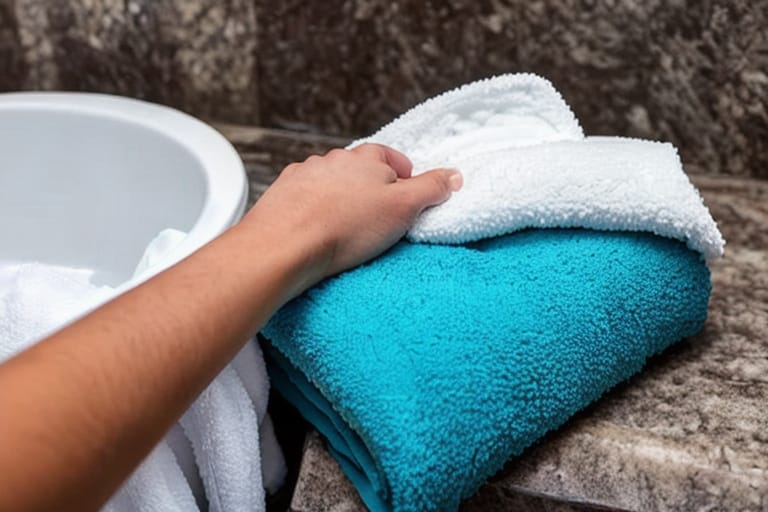Down-filled duvets and comforters are incredibly warm, fluffy, and comfortable. But they can get dirty over time, collect dust mites, and require cleaning to stay fresh and allergen-free. Many wonder if it’s possible to clean these delicate items at home, or if dry cleaning is an absolute must.
This beginner’s guide will give you a crash course in caring for down bedding. You’ll learn:
- If machine washing destroys down and risks clumping
- Pro tips for handwashing down at home
- How to safely dry and fluff down comforters
- When to use professional laundering services
- Key mistakes to avoid with down bedding
Let’s dive into proper techniques for washing those fluffy down-filled items so you can keep them clean and cozy for years to come!
Down Comforters
Before learning how to wash down, it helps to understand what, exactly, is inside that fluffy duvet.
What Is Down?
Down refers to the fine, fluffy clusters and plumules that sits underneath the exterior feathers of ducks and geese. This delicate undercoating provides insulation and warmth for the birds.
For bedding use, manufacturers source high-quality down plumules from farms or as a byproduct of the food industry. Down clusters have incredible insulating properties while remaining very lightweight and compressible.
Down Comforter Fabrics
The fluffy down fill is encased inside a stitched fabric shell made of cotton, cotton-blend, polyester, silk, or other textiles. Some down comforters also have a baffle-box design with interior fabric walls that prevent the fill from shifting.
Fill Power
Fill power measures the loft and quality of down insulation. Higher fill powers correlate to more air trapping properties and warmth for the weight. Fill powers typically range from 400 to 900.
| Fill Power | Quality |
|---|---|
| 400-450 | Low |
| 500-550 | Decent |
| 600-650 | Better |
| 700-900+ | Best |
Why Should You Wash Down?
It’s tempting to avoid washing delicate down bedding. However, regular cleaning provides essential benefits:
Removes oils, soils, sweat
Down comforters become soiled from regular use. Cleaning helps remove body oils, sweat, and dirt that can degrade down over time.
Eliminates dust mites Dust mites feed on skin cells and multiply rapidly in bedding. Washing regularly kills them and removes allergens.
Reduces odors Over time, down absorbs odors that washing removes. This helps items smell fresh and clean long-term.
Fluffs and lofts down Washing and proper drying restores down’s fluffiness and insulation power that tends to compress over time.
Kills bacteria and germs Laundering is key for eliminating biofilm bacteria, mold spores and other germs that can harbor in bedding.
While dry cleaning down is an option, learning to wash down comforters at home saves time and money while allowing more regular cleaning for health.
Read Those Care Labels
The first step in washing down bedding is deciphering the care instructions. Check the manufacturer’s tag for proper washing methods.
Key things to look for:
- Machine wash – Can the comforter be washed in a home machine?
- Dry clean only – Should it be professionally cleaned?
- Water temperature – Warm, cool, or delicate cycle?
- Bleach – Are bleach products allowed?
- Drying method – Line dry or tumble dry on low?
Follow these instructions closely to prevent damage. When in doubt, always err on the gentle side with cool water, delicate cycles, and low heat.
Prewash Spot Cleaning
Before overall washing, inspect comforters and spot clean any stained areas:
- Food, makeup stains – Gentle dish soap and water
- Sweat, oils – Upholstery cleaner
- Ink, permanent marks – Alcohol or hairspray
Catch stains early before they set permanently. Avoid harsh scrubbing and let products soak in first.
Pro Tip: Check seams and fabric edges for clumped debris that may need cleaning.
Use a Duvet Cover
Using a removable duvet cover over your comforter adds an extra layer of protection from body oils and spills during use while allowing easy washing. Choose one that fits well without compressing the down.
Handwashing Down Comforters
Many experts recommend washing down comforters by hand for best results. With some elbow grease, patience, and proper technique, you can get superior cleaning without risk of damage.
Fill (or empty) a bathtub with lukewarm water and a mild detergent solution. Choose a high-efficiency liquid detergent.
Submerge the comforter and allow it fully saturate. Let it soak for 15-30 minutes so the detergent can penetrate the down fill.
Pro Tip: Weigh down the comforter with clean towels to keep it immersed.
Gently press and knead across the surface without wringing to release soils. Focus on any visible stains first.
Drain dirty water and refill the tub with clean water to rinse. Press out suds until the water runs clear.
Tip: Change rinse water multiple times for a thorough clean.
Machine Washing Down Bedding
Home machines can successfully clean down comforters if using the right gentle settings and cycles.
Choose a large-capacity washer that allows items to move freely. Standard machines may be too small.
Use a mild, high-efficiency detergent like Woolite or laundry soap for delicates. Avoid scented products.
Select the gentle/delicate cycle on cold or with warm water max. These lighter washes prevent damage.
Add a couple tennis balls to tumble with the comforter. This helps break up clumping during the cycle.
Check frequently and stop the washer immediately if any bunching occurs. Catch issues early before irreversible tangling happens.
Air dry if possible or lowest heat tumble dry with wool dryer balls added to the cycle.
Drying Down Comforters
Proper drying is imperative after washing down bedding to restore loft and prevent moisture issues.
Air Drying
The best practice is air drying down comforters whenever possible:
- Hang outside on a clothesline on a low-humidity day
- Lay flat on top of a drying rack, allowing air access top and bottom
- Drape over multiple pieces of outdoor furniture
Fluff and massage throughout the day. Bring indoors before night temperatures drop.
Machine Drying
If air drying isn’t possible, use an appliance on delicate low heat:
- Dryer balls can help prevent clumping
- Remove promptly when still slightly damp
- Further air dry item flat until fully dry
Avoid over-drying as it can damage down insulation.
Pro Tip: Throw a couple clean tennis balls in the dryer to fluff down
Restoring Down Loft
Once fully dried after washing, you may need to manually “fluff” areas that appear compressed or matted.
Vigorously shake out and squeeze clumps of down through your fingers while redistributing fill evenly.
Use a hard bristle brush to gently brush flattened sections on low heat.
Tennis balls also help break apart matted down when tumbled together on delicate heat.
With some time and elbow grease, you can restore your down comforter to its original fluffy glory!
Removing Down Comforter Stains
Accidents happen, but you can tackle many fresh stains at home without fully washing the entire comforter:
Food stains – Spray with dish soap and cold water. Use a soft brush and rinse clean.
Oil/grease spots – Gently dab liquid dish soap and lift out the spot using paper towels or a clean rag underneath.
Drink spills – Soak up promptly then mist with diluted white vinegar and water. Blot area with towel.
Sweat/odor marks – Sprinkle liberally with baking soda. Let sit 1 hour before vacuuming up.
Ink/permanent marker – Apply rubbing alcohol to backside first so it pushes stain through fabric instead of spreading.
For difficult dried-on stains, seek professional spot cleaning or laundering services. Harsh scrubbing can further set stubborn marks.
Maintaining Down Duvet Covers
Caring for the duvet cover encasing your down comforter is also essential. Follow these best practices:
Wash frequently – Clean outer duvet covers regularly to limit soils reaching inner down fill.
Choose durable fabrics – Opt for tightly woven cottons/polyesters. Avoid delicate silk or satin prone to tearing.
Inspect zippers – Replace any damaged zippers to prevent interior down escaping.
Mend small holes/tears promptly or replace duvet completely if badly damaged.
Machine wash and dry with other bed linens using mild detergent on cool, delicate settings.

Why Professional Cleaning?
Some down bedding may require professional laundry or dry cleaning services. This is the best route for:
Heavily soiled items – Launderers use commercial washers to fully saturate and rinse multiple times.
Stubborn odor removal – Ozone treatments help eliminate tough lingering smells.
Treatment of mold/mildew – Commercial sanitization removes bio-contaminants from bedding.
Down disinfection – Heat treatments kill dust mites and microbes without damaging clusters.
Thorough stain removal – Technicians have access to stronger spot cleaning chemicals.
Items labeled “Dry Clean Only” – Some bedding must undergo chemical cleaning due to fabrics, construction technique or the amount/type of down fill.
Reputable professional cleaners are experienced in properly caring for delicate down items. Ask about their specific process before entrusting cherished bedding.
Alternative “Dry” Cleaning Methods
Traditional dry cleaning uses harsh PERC solvents inappropriate for down materials. Thankfully, greener dry cleaning alternatives exist:
Wet cleaning – Uses water, specialized detergents, and high-tech machines for fine fabrics
CO2 cleaning – Liquid CO2 plus gentle soap molecules dissolve soils then convert to gas
Liquid silicone (D5) – Non-toxic synthetic fluid provides safe cleaning of delicates
Ozone treatment – Oxidizes odors and sterilization without moisture or chemicals
Steam cleaning – Hot vapor under pressure penetrates fabrics to loosen soils
Ask your professional laundering service if they offer any of these gentler cleaning processes suitable for down comforters.
Keeping Down Bedding Fresh
While periodic deep cleaning restores down comforters, some maintenance between washes keeps them cleaner and fresher:
- Spot clean spills/stains promptly
- Air out bedding regularly in sunshine
- Use wool dryer balls when drying linens to prevent down clumping
- Steam clean pillows/mattress to kill dust mites
- Add a mattress protector to shield from skin oils/sweat
- Wash or replace duvet cover frequently
- Fluff and redistribute filling monthly
Time Between Washes?
How often should you deep clean down comforters? Experts suggest:
If using a duvet cover – Every 2 years Without a duvet cover – Annually For allergy/asthma sufferers – Twice yearly minimum
However, wash any bedding immediately if:
- You see visible staining
- Notice musty or sour odors
- Experience nighttime allergy symptoms
- Detect mold, mildew or bug infestations
Don’t wait until annual laundering if soiling or contamination occurs first.
Seeking a happy medium of washing down comforters only when truly needed balances health with preservation of delicate clusters. But err on the side of caution if cleanliness is in question.
Eco-Friendly Care of Down Bedding
Washing down insulation sustains its lifespan while benefiting environmental health through:
Conservation
Choosing sustainably-sourced down from ethical suppliers helps conserve waterfowl populations. Opt for Responsible Down Standard (RDS) certified materials.
Reduced Waste
Natural down durability in proper care means no frequent replacement of bedding in landfills. Proper maintenance cuts waste.
Cleaner Air
Vacuuming then washing down removes up to 98% of dust mite allergens. This creates healthier household air and may reduce allergy medication consumption.
Lower Energy
Line drying down comforters maximizes solar energy for drying instead of heat generated by electric or gas appliances.
Reuse + Upcycling
Repurposing tattered down bedding for dog beds, jacket insulation or furniture cushions gives items extended usefulness.
Health + Safety Notes
When caring for down-filled items in your home, keep these health and safety guidelines in mind:
Use allergen-proof covers – Encase mattresses/pillows in protective covers that keep dust mites, dander, etc sealed out even after washing.
Clean wash cycles – Run empty “allergen removal” washer cycles between loads. Wash bedding separately from other laundry.
Vent properly – Dry bedding with adequate ventilation to allow moisture and gases to escape outside.
No harsh chemicals – Avoid bleach, optical brighteners, synthetic scents that degrade delicate down and irritate those with chemical sensitivities.
Check on elderly/infants – Monitor bedding hygiene for those populations at higher risk for asthma attacks, infection transmission or SIDS.
Adequate down bedding cleaning provides peace of mind in protecting health while avoiding need for frequent chemical sanitization.
Troubleshooting Issues
Even with proper techniques, washing down comforters at home comes with some risks. Watch for these common mishaps:
Clumping – Use dryer balls to “beat up” comforter and redistribute down. For bad clumping, refill areas by hand.
Odor persistence – Rinse with distilled white vinegar or lemon juice solution. Machine dry fabric softener sheet for fresh scent.
Mold/mildew – Discard down if you see dark staining and rot. Mold spores difficult to kill without harmful chemicals.
Fabric pilling – Gentle detergents prevent pilling and damage to fabric shell. Avoid overloading washing machine.
Lost loft – Fluff regularly while drying then use tennis balls on low heat to restore insulation value.
Cover tearing – Mend small holes then encase comforter. Replace if cover is badly damaged and exposing down.
Thankfully with some troubleshooting, preventative care, and minor restoration efforts, most common washing issues are fixable at home without having to trash the comforter.
Quality Checks Post-Wash
After cleansing down bedding, conduct these quick checks that proper techniques were used:
🔎 Visual inspection – Look for stains remaining, holes/tears, missing down clusters
👐 Touch test – Manual check for smooth, fluffy texture without lumps
🚪 Doorway shake – Shake vigorously and ensure even down distribution by observing fill mid-air
With all comforters after washing, give them a final manual fluffing and reshaping on the bed before remaking tightly. Smooth out any remaining damp spots using your hands. Then enjoy your refreshed bedding!

Expert Wisdom for Down Comforter Care
Cleaning professionals and bedding experts share key guidance on home laundry methods for delicate down-filled items:
“Taking time to properly handwash down comforters restores fluffiness best. Rushing the process risks permanent clumping.” – Martha D., Laundress
“Always clean down comforters in early spring or fall when humidity is lower – quick drying preserves insulation.” – Ralph T., Dry Cleaner
“I swear by those wool dryer balls to keep down feathers from matting when machine drying on low heat.” – Lucy G., Textile Conservator
“To freshen in between washes, hang duvet in sunlight then gently beat with clean broom outside.” – Maria K., Housekeeping Director
By following pro tips from the cleaning pros combined with manufacturer guidance, you can keep down comforters clean while avoiding damage through improper washing techniques.
Frequently Asked Questions
Can you machine wash a down comforter at home?
Yes, you can machine wash down comforters at home on a gentle or delicate cycle in cold water. Be sure to use a mild detergent and add a couple tennis balls to the wash to prevent clumping. Air dry or tumble dry on very low heat.
How often should you wash a down comforter?
Experts typically recommend washing down comforters every 2 years if using a removable duvet cover. Wash at least annually without a cover. However, clean immediately if you see stains or signs of dust mites or odors.
Why does my down comforter have a smell after washing?
A lingering odor after washing means excess moisture was trapped in the down fill. Be sure to dry thoroughly by air drying completely or tumble drying on a delicate cycle with dryer balls. Repeat drying if needed until fully dry.
Can you put a down comforter in the dryer?
Yes, you can machine dry down comforters on very low heat as long as they are dried thoroughly and removed immediately before over-drying. Add a couple tennis balls to help redistribute fill. Air drying is best to preserve loft.
How do you wash a down comforter by hand?
To handwash, fill a bathtub with lukewarm water and mild detergent. Fully submerge the comforter, weigh it down, let it soak 30 minutes. Gently press and knead without wringing before draining dirty water. Refill to rinse multiple times until water runs clear.
Why does my down comforter have brown spots?
If you notice staining on a down comforter, check for signs of mold or mildew which can cause brown or black dots. This may happen if drying was insufficient after washing. Discard item if rotted. For other mystery stains, spot treat gently with dish soap prior to washing.








